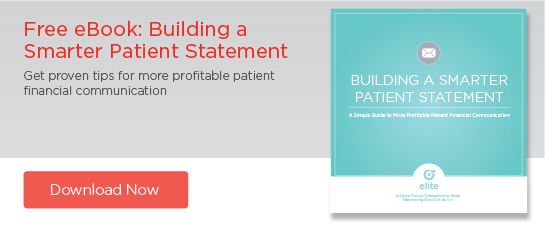A Smart Plan for Collecting Self-Pay Balances at Every Opportunity
May 12, 2015 •Brian Watson

 Like it or not, your patients are set to become a permanent fixture in revenue collection – if they aren’t already.
Like it or not, your patients are set to become a permanent fixture in revenue collection – if they aren’t already.
With the continued rise in patient consumerism, patients simply have a much more vested interest in care delivery these days. Whereas the typical patient with insurance has long been largely shielded from the true costs of treatment, thanks to more cost sharing between employers and workers and the launch of ACA insurance exchanges, recent inflation is increasingly borne by consumers.
In the last decade alone, the average annual premium for employer-sponsored health insurance has increased by 69%, with employee contribution rising by 81% over that same period. According to a 2014 Kaiser Family Foundation report, 80% of employees covered by a sponsored health plan have a general annual deductible – $1,135 per year on average. And nearly three-quarters are expected to pay a copayment in addition to their deductible.
Increased cost sharing – and corresponding patient out-of-pocket spending – is also a growing trend in government-sponsored state and federal health insurance exchanges.
As of February 2015, the U.S. Department of Health & Human Services estimates that nearly 11.4 million Americans have enrolled in private coverage through an exchange. Of patients enrolled, a majority have opted to trade higher out-of-pocket costs for lower premiums: 81% of plans purchased include high levels of cost sharing.
Moving Towards BAI
A larger portion of revenue from direct patient sources is a justifiable cause for concern for many providers.
Many revenue cycles are structured to collect from primary revenue sources – Medicare, Medicaid, and private insurance payers – not from self-pay patients. Unsurprisingly, recovering directly from patients typically takes longer, is more expensive, and requires more hands-on attention and care. Consider that:
• Collecting directly from patients can cost twice as much as from payers.
• It takes an average of 3.3 billing statements to collect from patients, and they pay twice as slowly as commercial payers as a group.
• Self-pay accounts exhaust scarce resources, monopolizing staff and requiring $25 per average re-bill.
In addition, rising out-of-pocket costs are likely to have a considerable impact on provider bad debt levels – for reasons both good and bad.
Enrollments in private coverage through insurance exchanges are likely to slow the rapid expansion of healthcare bad debt over the next few years. In 2013, hospitals provided over $46 billion in uncompensated care – an increase of over 60% since 2003. But with ACA exchanges expected to provide coverage for up to 30 million previously uninsured Americans, that figure could drop by as much as 25% by 2018.
While reduced bad debt is obviously a positive outcome, collecting a higher portion of bad debt from patients with a balance after insurance (BAI) could also reduce the return on investment of collection activities and threaten patient satisfaction.
Accounts with a BAI could make up more than a third of hospital bad debt within the next few years, with many falling into small dollar liability categories. Given that 1 in 3 Americans struggle to pay medical bills – and that 70% of those that do so already have insurance – coverage alone does not guarantee propensity to pay. For example, medical bills are the most consistently delinquent consumer billing category – with 34% of respondents paying late.
Factoring in re-billing and collections costs, providers will likely find it trickier to profitably recover BAI accounts with a small dollar liability. Particularly as patients insured through exchanges are likely to be at a higher risk of non-payment – due to lower credit scores and fewer household assets.
Rethinking Self-Pay
Providers who collect at time of service have a 90% or better probability of collecting patient payments. But the risk of non-payment increases quickly thereafter: at three months post-encounter, the odds of receiving a payment drop to 73%. Six months removed, the likelihood of collecting is just 57%. In fact, providers are 62% less likely to collect anything at all from a patient once they leave the facility.
With out-of-pocket patient financial responsibility approaching historical levels, it’s critical that patient financial engagement strategies preserve margins and minimize the financial pressure from self-pay patients.
For many providers, that means more proactively embracing tools that help transition collection activities from post-encounter to patient access and point-of-service. Or by working with patients before care delivery to help them better anticipate and manage financial responsibility.
In the rest of this post, I’ll outline four-step process to help you more effectively communicate patient financial responsibility throughout care delivery.
Pre-Encounter
Initiating billing discussions during patient access is a smart way to improve patients’ understanding of your financial policies and their out-of-pocket obligations before they arrive for treatment.
Better financial engagement reduces the risk of unanticipated costs and signals your concern for patients’ well being – both physical and financial. When patients grasp the financial side of their care, they're able to make better choices about things like preventative care and the viability (financial and otherwise) of different treatment options.
From a revenue cycle standpoint, pre-encounter activities help make it faster, easier, and more efficient to collect from patients.
• Use appointment reminder calls, emails, and text messages to confirm insurance coverage and remind patients of their financial responsibility at the time of treatment.
• Clearly communicate any financial programs you offer – including structured payment plans or prompt pay and/or cash-only discounts – as well as financial aid/charity care guidelines and application tools.
• Nearly two-thirds of Americans are consistently surprised by their health bills. Help patients better understand the costs of care with accurate pre-treatment balance estimates. Many providers are now integrating insurance eligibility and verification with payer contract pricing to supply patients with an actionable, transparent snapshot of cost. In addition, providing estimation tools through a web portal can help improve patient adoption of online billing and payment.
• Use propensity-to-pay analytics to identify patients that are eligible for financial assistance. Being proactive in seeking out patients that might have difficulty meeting financial obligations enables immediate financial counseling and introduction of personalized payment options.
Point-of-Service
Putting in the ground-work during pre-encounter to help patients understand what is expected of them financially helps build transparency, fairness, and accountability into healthcare delivery. It also helps establish the conditions to collect at least a portion of what is owed before a patient has left your facility following an encounter – the most efficient time for payment.
To build on that foundation, make it fast, convenient, and simple for patients to pay. That includes offering multiple point-of-service pay options – like payment plans or a revolving line of credit – and access to several, hassle-free payment channels.
• Develop an easy-to-understand financial policy that covers areas like what you expect patients to pay, by when, and the consequences for non-payment. And make it readily available – both in person and on your website.
• Offer as many payment options as possible. That includes typical options like credit cards, debit cards, checks, and cash. But also alternatives for patients that want to pay using non-traditional options, like a Healthcare Savings Account, medical credit card, installment loan, or revolving line of credit.
• Give patients more payment flexibility. For example, payment plans for patients that might struggle to cover an entire balance due all at once, or pre-authorizations for those that wish to get a head-start on paying for future services.
• Encourage up-front enrollment in patient engagement tools that accelerate payment and reduce collection costs. Patient access is the best time to capture patients’ email addresses and phone numbers for SMS text message alerts and reminders. In addition, providing an incentive – like a balance discount or gift card – is a smart way to patient boost adoption of an online billing and payment portal.
The First 30 Days
Given how quickly the value of receivables depreciate, it’s critical to stay top-of-mind with patients during the first thirty day windows – when the probability of collecting is much higher and costs are more manageable.
But there’s a balance to be maintained. Too many touches could threaten both patient satisfaction and the health of your margins. It pays to be selective – using channels that maximize engagement and minimize both billing costs and disruption to patients
• Provide 1-2 payment reminders during the first 30 days post-treatment. Efficient, easy-to-manage patient engagement channels include e-mail, text message, and automated IVR phone messaging
• Give patients the opportunity to use an online portal to make pre-authorized payments on a self-pay balance before a statement arrives
• Send statements as soon as possible. Daily statement processing from billing files is a best-practice to shoot for, if feasible. Leading statement processing vendors shouldn’t have a problem guaranteeing one-business-day delivery of statements once a file is received in a service level agreement
• Use clean, easy-to-understand statement design to accelerate payment and reduce call center activity. Patient friendly billing should help simplify transaction data, highlight key billing details and quickly communicate the full range of payment options you offer patients.
• Offer patients payment flexibility. Fast access to a variety of easy-to-use billing and payment tools (web, email, mobile, IVR, and mail) enhances the convenience factor and speeds payments by enabling patients to pay when and how they choose.
Collections
Debt collection often requires a delicate balancing act.
Recovery activities are a critical part of highly performing revenue cycles. On the other hand, if performed poorly, they can badly damage relationships with patients, chip away at brand equity, or even result in loss of not-for-profit status. Patients hold providers responsible for the actions of companies collecting on their behalf – not the vendors pursuing debt.
Consequently, it pays to exhaust all the tools at your disposal to avoid referring patients for collections and put a high degree of due diligence into both your internal policies and external relationships.
• Consider using propensity-to-pay analytics to segment patients into groups for more efficient and appropriate follow-up. For example, an account with an overdue balance but high propensity to pay might receive targeted statement messaging. While a patient with a high balance due that lacks household assets might be approached with a specialized financial plan to incrementally tackle debt.
• Pay careful attention to key indicators, like the percent of accounts in 30, 60, 90, or 120 receivables aging buckets and net days in A/R to stay on top of accounts in danger of collections.
• Set a consistent collection policy that clearly states when an account can be referred for proceedings, exempt populations, and guidelines for collection vendors
The Wrap-Up
Healthcare consumerism is no fad. With deductibles rising and cost sharing increasing, patients will be a more prominent part of payment activities for the foreseeable future.
Meet their unique payment needs and preferences with smart financial engagement strategies – like those outlined here – from patient access through financial communication.
Get Updates
Featured Articles
Categories
- Charity Care Management (1)
- Compliance (2)
- Customer Service (8)
- Digital Front Door (1)
- Direct Mail (6)
- eBilling (1)
- EBPP (34)
- ESL Statement (2)
- eStatement (1)
- Healthcare Channel Partner Billing (1)
- IVR (3)
- Mobile Payment (11)
- Online Billing and Payment (6)
- Online Patient Payment (17)
- Outsource Print Management (4)
- Paperless Billing (4)
- Patient Engagement (2)
- Patient Friendly Billing (21)
- Print and Mail (7)
- QR Codes (1)
- Quick Pay (7)
- Security (1)
- Self-Pay Patients (9)
- Self-Pay Revenue (4)
- Statement Design (32)
- Statement Print and Mail (1)
- Statement Printing and Mailing (28)
- Statement Processing (36)
- TransPromo (1)
- Up-Front Billing (1)


